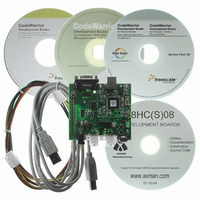DEMO9S08EL32 Freescale Semiconductor, DEMO9S08EL32 Datasheet - Page 82

DEMO9S08EL32
Manufacturer Part Number
DEMO9S08EL32
Description
BOARD DEMO FOR 9S08 EL MCU
Manufacturer
Freescale Semiconductor
Type
MCUr
Datasheets
1.DEMO9S08EL32.pdf
(356 pages)
2.DEMO9S08EL32.pdf
(14 pages)
3.DEMO9S08EL32.pdf
(2 pages)
Specifications of DEMO9S08EL32
Contents
Evaluation Board
Processor To Be Evaluated
MC9S08EL32
Data Bus Width
8 bit
Interface Type
RS-232, USB
Operating Supply Voltage
12 V
Silicon Manufacturer
Freescale
Core Architecture
HCS08
Core Sub-architecture
HCS08
Silicon Core Number
MC9S08
Silicon Family Name
S08EL
Rohs Compliant
Yes
For Use With/related Products
MC9S08EL32
Lead Free Status / RoHS Status
Lead free / RoHS Compliant
- Current page: 82 of 356
- Download datasheet (9Mb)
Chapter 6 Parallel Input/Output Control
6.3.3
The port interrupt pins can be configured to use an internal pull-up/pull-down resistor using the associated
I/O port pull enable register. If an internal resistor is enabled (PTxPEn=1) and the pin is selected for
interrupt (PTxPSn=1), the PTxES register is used to select whether the resistor is a pull-up (PTxESn = 0)
or a pull-down (PTxESn = 1).
6.3.4
When an interrupt pin is first enabled, it is possible to get a false interrupt flag. To prevent a false interrupt
request during pin interrupt initialization, the user should do the following:
6.4
Pin behavior following execution of a STOP instruction depends on the stop mode that is entered. An
explanation of pin behavior for the various stop modes follows:
6.5
This section provides information about the registers associated with the parallel I/O ports. The data and
data direction registers are located in page zero of the memory map. The pull up, slew rate, drive strength,
and interrupt control registers are located in the high page section of the memory map.
Refer to tables in
pin control registers. This section refers to registers and control bits only by their names. A Freescale
Semiconductor-provided equate or header file normally is used to translate these names into the
appropriate absolute addresses.
82
1. Mask interrupts by clearing PTxIE in PTxSC.
2. Select the pin polarity by setting the appropriate PTxESn bits in PTxES.
3. If using internal pull-up/pull-down device, configure the associated pull enable bits in PTxPE.
4. Enable the interrupt pins by setting the appropriate PTxPSn bits in PTxPS.
5. Write to PTxACK in PTxSC to clear any false interrupts.
6. Set PTxIE in PTxSC to enable interrupts.
•
•
Stop2 mode is a partial power-down mode, whereby I/O latches are maintained in their state as
before the STOP instruction was executed. CPU register status and the state of I/O registers should
be saved in RAM before the STOP instruction is executed to place the MCU in stop2 mode. Upon
recovery from stop2 mode, before accessing any I/O, the user should examine the state of the PPDF
bit in the SPMSC2 register. If the PPDF bit is 0, I/O must be initialized as if a power on reset had
occurred. If the PPDF bit is 1, I/O data previously stored in RAM, before the STOP instruction was
executed, peripherals may require being initialized and restored to their pre-stop condition. The
user must then write a 1 to the PPDACK bit in the SPMSC2 register. Access to I/O is now permitted
again in the user application program.
In stop3 mode, all I/O is maintained because internal logic circuity stays powered up. Upon
recovery, normal I/O function is available to the user.
Pin Behavior in Stop Modes
Parallel I/O and Pin Control Registers
Pull-up/Pull-down Resistors
Pin Interrupt Initialization
Chapter 4,
MC9S08EL32 Series and MC9S08SL16 Series Data Sheet, Rev. 3
“Memory,” for the absolute address assignments for all parallel I/O and their
Freescale Semiconductor
Related parts for DEMO9S08EL32
Image
Part Number
Description
Manufacturer
Datasheet
Request
R
Part Number:
Description:
Manufacturer:
Freescale Semiconductor, Inc
Datasheet:
Part Number:
Description:
Manufacturer:
Freescale Semiconductor, Inc
Datasheet:
Part Number:
Description:
Manufacturer:
Freescale Semiconductor, Inc
Datasheet:
Part Number:
Description:
Manufacturer:
Freescale Semiconductor, Inc
Datasheet:
Part Number:
Description:
Manufacturer:
Freescale Semiconductor, Inc
Datasheet:
Part Number:
Description:
Manufacturer:
Freescale Semiconductor, Inc
Datasheet:
Part Number:
Description:
Manufacturer:
Freescale Semiconductor, Inc
Datasheet:
Part Number:
Description:
Manufacturer:
Freescale Semiconductor, Inc
Datasheet:
Part Number:
Description:
Manufacturer:
Freescale Semiconductor, Inc
Datasheet:
Part Number:
Description:
Manufacturer:
Freescale Semiconductor, Inc
Datasheet:
Part Number:
Description:
Manufacturer:
Freescale Semiconductor, Inc
Datasheet:
Part Number:
Description:
Manufacturer:
Freescale Semiconductor, Inc
Datasheet:
Part Number:
Description:
Manufacturer:
Freescale Semiconductor, Inc
Datasheet:
Part Number:
Description:
Manufacturer:
Freescale Semiconductor, Inc
Datasheet:
Part Number:
Description:
Manufacturer:
Freescale Semiconductor, Inc
Datasheet:










